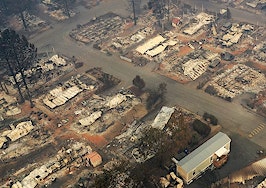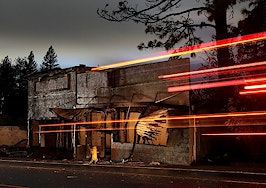Christy Edgar Murdock is a regular Inman contributor who writes about news, tech and marketing. She has two recurring columns, “Lessons Learned” and “Dear Marketing Mastermind” that publish weekly and monthly on Mondays and Tuesdays respectively.
The recent Camp wildfire in Northern California’s Butte County and Woolsey wildfire in Los Angeles County captured headlines as they decimated communities, swallowing everything in their path and forcing the evacuation of countless people, including celebrities from their multi-million-dollar homes.

Nick Giovacchini
We reached out to Nick Giovacchini of San Francisco-based real estate investment firm AlphaFlow to find out how these massive disasters have impacted the region thus far, and how they will continue to do so in the weeks, months and years ahead.
With a background in risk analytics and index solutions, working with institutional asset managers to analyze risk and performance drives of their portfolios, Nick has unique insight into the impact of natural disasters on investment, as well as how investors — and their real estate advisors — can be prepared for what’s to come.
Tell us what we need to know about the impact of the California fires on real estate, both residential and commercial.
The fires lasted about 18 days from start to total containment. The Camp fire in Butte County had roughly 14,000 homes impacted, with 13,500 of those destroyed completely. There were about 530 commercial buildings and an additional 4,000 structures of various kinds destroyed as well. 153,000 acres burned with about $7.5 to $10 billion dollars.
To give you an idea of the destruction level, there were about 50,000 homes in the Butte County area and almost 14,000 (approximately one-third) were destroyed. The impact on infrastructure has been massive as many bridges were destroyed in rural Butte, and it’s part of FEMA’s mandate to create the infrastructure needed to begin recovery.
Heading south to the Woolsey fire in the areas around Malibu, 97,000 acres were impacted with a little more than 1,500 structures destroyed. The fires in Woolsey had a huge impact in terms of the displacement of residents, but were ultimately far less destructive than the Camp fires. Of course, the impact is huge for the people affected, but in terms of the percentage of people impacted it’s statistically different.
Agriculture is so much a part of California’s economy, especially the wine industry. What are the impacts you are seeing there?
The area up in Butte County is not a massive agricultural area, but a big part of the economy is based on ranching. For that reason, the displacement from the fires is not just of people but of livestock, and ranchers have worked together to find places to house displaced animals on ranches that were not destroyed.
In terms of pure agricultural impact, a lot of farms around Los Angeles and Southern California evacuated early and expedited their harvest when the fires first started, so that helped prevent some of the bigger commercial impacts.
Overall, the impact was far greater on the residential side.
Terroir is so integral to the production of wine — air quality, soil quality, and water quality all have a huge effect. What are you hearing regarding the long-term effects of the fires on these elements?
The biggest fear when it comes to wine is that there will be a smokey flavor to the wine itself. Fortunately, because these fires came so late in the growing season when much of the harvest had been completed, we’re not seeing the effects we might have if the fires had taken place in August or September.
The Malibu Coast American Viticultural Area (AVA) was an exception — it was really shattered by the fires, and we don’t have a full impact assessment yet. Napa, Sonoma and Simi Valley seem to have fared far better. As California is undergoing these cycles of drought followed by heavy rain, the longer term impact has yet to be fully understood.
You went to school in D.C. and have an academic background in political science. What are your thoughts about the governmental response to the fires?
Governor Jerry Brown and Governor-elect Gavin Newsom took action and requested relief early on, which got FEMA involved relatively quickly. And both the Secretary of the Interior and the Secretary of Agriculture toured the Northern California area.
Climate change is fueling events like these, and while there are many conversations centered around the cause, we need to start focusing on preparing communities to respond quickly and safely in these situations.
We also need to ask where the funding and manpower come from to deal with disasters. People having to actually coordinate the response to these incidents should have this information.
What should investors think about when considering investments in California real estate going forward?
Investors should make sure the property under consideration is adequately insured and protected. They should also consider the impact a major disaster will have on market values when there are lawsuits and damage assessments involved. In Butte County, for example, people will be in wait-and-see mode for a while.
As homebuyers look at areas and properties, they’ll need to factor in the potential for these types of disastrous events. And it’s important for buyer’s agents to look at how natural disasters have been managed in the area their clients are interested in.
Real estate agents should ensure that their buyers are as well-protected as possible, and part of that means helping those buyers understand where homes are at higher risk and what that means for them.
Christy Murdock Edgar is a Realtor, freelance writer, coach, and consultant with Writing Real Estate and a Brand Ambassador and content marketer forApartmentPostcards.com. Follow Writing Real Estate on Facebook, Twitter or Instagram.









